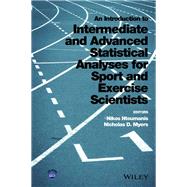"Ntoumanis and Myers have done sport and exercise science researchers and students a tremendous service in producing An Introduction to Intermediate and Advanced Statistical Analyses for Sport and Exercise Scientists. This book has an outstanding compilation of comprehensible chapters dealing with the important concepts and technical minutia of the statistical analyses that sport and exercise science scholars use (or should be using!) in their efforts to conduct meaningful research in the field. It is a resource that all sport and exercise scientists and their students should have on their book shelves."
—Robert Eklund, School of Sport, University of Stirling, UK
"Motivating, to have a statistics text devoted to enabling researchers studying sport and exercise science to apply the most sophisticated analytical techniques to their data. Authors hit the mark between using technical language as necessary and user-friendly terms or translations to keep users encouraged. Text covers traditional and well-used tools but also less common and more complex tools, but always with familiar examples to make their explanations come alive. As a dynamic systems theorist and developmentalist, I would love to see more researchers in my area create study designs that would enable the use of tools outlined here, such as multilevel structural equation modeling (MSEM) or mediation & moderation analyses, to uncover cascades of relations among subsystems contributing to motor performance, over time. This text can facilitate that outcome."
—Beverly D. Ulrich, School of Kinesiology, University of Michigan, USA
"The domain of quantitative methods is constantly evolving and expanding. This means that there is tremendous pressure on researchers to stay current, both in terms of best practices and improvements in more traditional methods as well as increasingly complex new methods. With this volume Ntoumanis and Myers present a nice cross-section of both, helping sport and exercise science researchers to address old questions in better ways, and, even more excitingly, to address new questions entirely. I have no doubt that this volume will quickly become a lovingly dog-eared companion for students and researchers, helping them to continue to move the field forward."
—Gregory R. Hancock, University of Maryland and Center for Integrated Latent Variable Research (CILVR), USA








